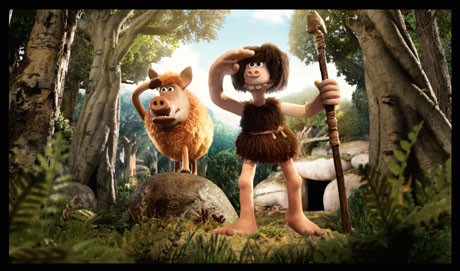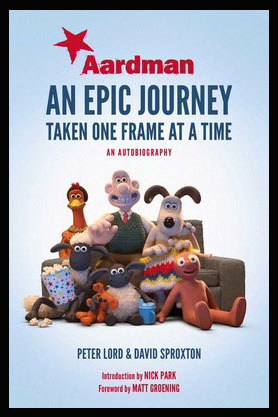
For decades, “animation” meant drawn animation in America. Except for George Pal’s Puppetoons, stop-motion was a minor variant, used for movie monsters, Alka-Seltzer commercials and the occasional holiday special. But in recent years stop-motion animation has enjoyed an unprecedented efflorescence. One of principle creators of that flowering is the Aardman Animations studio.
The found dialogue in Down and Out and other Aardman shorts pushed ideas John and Faith Hubley had explored in bold new directions. The vivid character animation in Creature Comforts, and the Wallace and Gromit and Shaun the Sheep films proved that clay could be as subtle and expressive a medium as drawings or CG. When Gromit looks up from his knitting at the sinister yet ridiculous Penguin in The Wrong Trousers, audiences believe the character is thinking, just as Jiminy Cricket in Pinocchio and Remy in Ratatouille are.

Although the studio has been the subject of several books—“Art of” tomes linked to their features and a couple of how-to stop motion manuals–“Epic Journey” is the first history of the Aardman studio, informally told by co-founders Peter Lord and David Sproxton.
The future partners met at Woking County Grammar School for Boys when they were 12. They quickly became friends, and began experimenting with filmmaking a few years later. While still in high school, Lord and Sproxton sold their first film to the BBC’s Vision On: a 25-second 2D film of a character they dubbed Aardman.
But the two young men discovered they preferred stop-motion animation of Plasticene figures to drawing. They used clay to create their first hit character, Morph, a simple but appealing homunculus who remains a favorite with viewers. The Aardman’s early BBC successes led to commercials, short films and music videos, including George Michael’s “Sledge Hammer.”
In 1985, a shy young artist joined the Aardmans after working for them in two-month stints while trying to finish his student film, A Grand Day Out. Nick Park went on to win four Oscars—one more than Meryl Streep–and introduce viewers to the addled world of Wallace and Gromit.
Sproxton and Lord are frank but not bitter about their forays into Hollywood studios. They clearly did not care for the treatment they received from Disney executives, but they write about Jeffrey Katzenberg with respect and affection. Although they made imaginative features at DreamWorks and Sony, winning an Oscar for The Curse of the Were-Rabbit, their American co-productions failed to attract the audiences they deserved.

Lord and Sproxton acknowledge that one problem they faced with both American executives and American audiences is that Aardman is a very British studio. Their humor continues the great tradition of British absurdity that includes “The Goon Show” and “Monty Python’s Flying Circus.” The Aardman films feature befuddled characters and clever word plays, rather than wise guys doling out sitcom one-liners. Many of their features offer brilliant mime animation and delightfully eccentric individuals; American audiences have grown to expect talky films filled with bodily function jokes.
By staying true to their vision, the Aardmans achieved impressive success: Their characters have become the stars of theme park attractions, and Shaun merchandise alone brings in an estimated $50 million a year. But few of the Aardman’s American fans know about their charity work, including special merchandise that raises money for Bristol Children’s Hospital. (Visit https://gromitunleashedshop.org.uk/collections/gromit-figurines).
When Sproxton and Lord thought about the long-term future of their studio, they agreed they didn’t want it become an asset on a corporate roster to be exploited and discarded. They decided to transfer the majority of the company’s shares to a trust that will hold them on behalf of the artists who work at Aardman, although neither partner is planning to retire.
“An Epic Journey” reads like friendly conversation with its authors, best enjoyed with cup of tea and some crackers and cheese—perhaps Wensleydale.

Aardman: An Epic Journey Taken One Frame at a Time: An Autobiography
By Peter Lord & David Sproxton
Simon & Schuster: $18.76; hardcover: 351 pp., illustrated.
- Charles Solomon’s Animation Year End Review 2023 - December 28, 2023
- INTERVIEW: Makoto Shinkai on “Suzume” - November 27, 2023
- Interesting Portrayals of Gay Men in Manga/Anime - June 12, 2023


 March 27th, 2019
March 27th, 2019  Charles Solomon
Charles Solomon  Posted in
Posted in  Tags:
Tags: 






